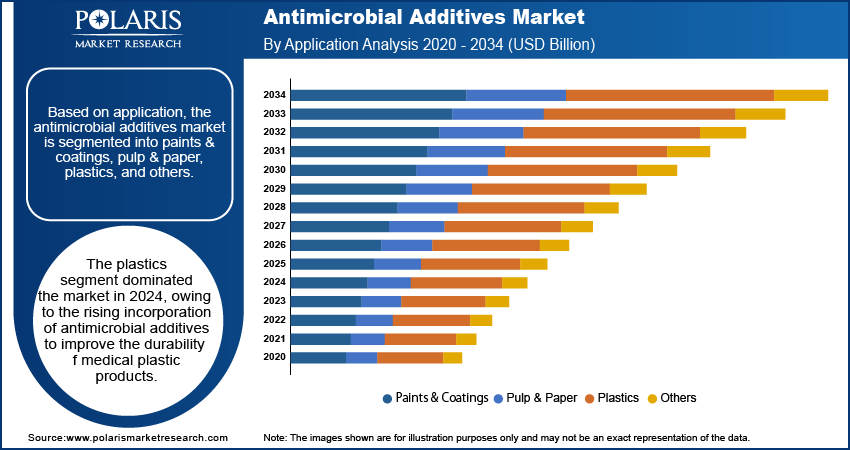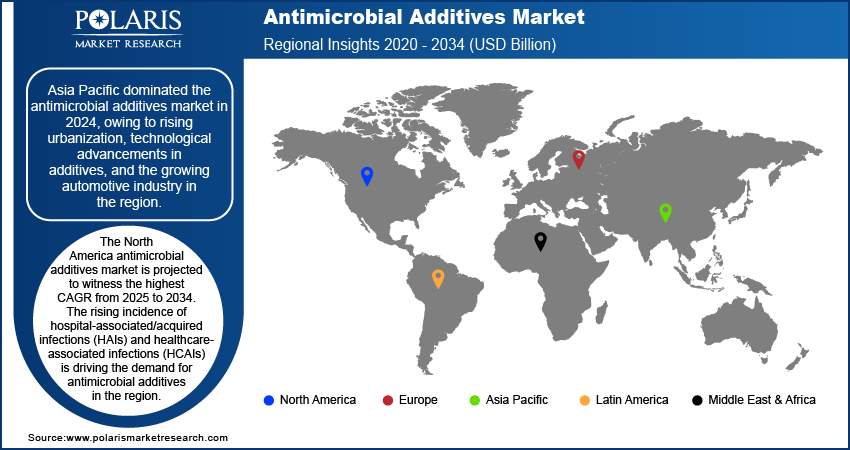
Antimicrobial Additives Market Size, Share, Trends, Industry Analysis Report
: By Type (Inorganic and Organic), Application, End-Use Industry, and Region (North America, Europe, Asia Pacific, Latin America, and Middle East & Africa) – Market Forecast, 2025–2034
- Published Date:Jan-2025
- Pages: 118
- Format: PDF
- Report ID: PM1260
- Base Year: 2024
- Historical Data: 2020-2023
Antimicrobial Additives Market Overview
The global antimicrobial additives market was valued at USD 3.51 billion in 2024. The market is projected to grow from USD 3.80 billion in 2025 to USD 7.96 billion by 2034. It is projected to exhibit a CAGR of 8.5% from 2025 to 2034.
Antimicrobial additives are substances that can inhibit the growth of microorganisms on a surface, thereby improving performance and durability of a variety of products such as paper, plastic, and food service equipment. The additives can be categorized as organic or inorganic. A few types of antimicrobial additives are silver ion technology, copper-based additives, quaternary ammonium compounds, and phenolic compounds.

To Understand More About this Research: Request a Free Sample Report
Silver is widely used in antimicrobial additives owing to its broad-spectrum performance and use in diverse materials and applications. It is highly effective in reducing cross-contamination, increasing functional lifetime, and improving durability. Zinc-based antimicrobial additives are known for their high chemical stability, increased sturdiness, and long life. They act against bacteria, fungi, mold, mildew, and algae. Antimicrobial additives are used in various applications, including technical textiles, bed rails, water tanks, paints, and polymer products.
The global antimicrobial additives market demand is fueled by rising industrialization; economic growth in countries such as China, Japan, and India; and growing demand from industries such as automotive, food & beverage, and textiles. Global players are expanding into developing countries to capitalize on the market potential offered by the automotive and construction sectors, further boosting the market growth.
Technological advancements, new product launches, and mergers and acquisitions between market participants are among the key trends anticipated to fuel antimicrobial additives market development across the globe during the forecast period. Growing disposable income, changing lifestyles, and increasing health awareness are anticipated to offer lucrative market opportunities for market players during 2025–2034.
Antimicrobial Additives Market Dynamics
Increased Utilization in Food Packaging Applications
Antimicrobial packaging solutions are designed to address food safety concerns and comply with stringent regulations. These packaging solutions help prevent food-borne infectious diseases, improve food quality, and extend the shelf life of food products. They offer functional barriers from the external environment and prevent the growth of microbes to prevent deterioration of food during processing, packaging, shipping, storage, and distribution. The increased utilization of antimicrobial additives in food packaging applications contributes to the antimicrobial additives market revenue.
Growing Use in Healthcare Industry
The rising prevalence of life-threatening diseases and health conditions has led to greater consumer awareness of health-related concerns. This shift has prompted medical device manufacturers to incorporate antimicrobial compounds into their production processes. The addition of antimicrobial additives into medical plastics helps prevent germs from sticking to the surface, thereby inhibiting the development of bacteria. Further, the growing need to adhere to health and hygiene standards to reduce the risk of cross-contamination in critical settings boosts the demand for antimicrobial compounds in the healthcare sector. Thus, the growing use of antimicrobial additives in the healthcare industry supports the antimicrobial additives market expansion.

Antimicrobial Additives Market Segment Insights
Antimicrobial Additives Market Outlook by Type Insights
The antimicrobial additives market, based on type, is bifurcated into organic and inorganic. The inorganic segment dominated the market and accounted for over 56% of the global market revenue share in 2024. Inorganic antimicrobial additives include materials such as zinc oxide, copper, and silver. Silver is known for its excellent antimicrobial efficacy and strong physical properties, making it widely used in applications such as paints, coatings, textiles, and medical equipment. Copper and zinc also provide antimicrobial protection and are used in industries such as healthcare, construction, packaging, and others. The increased demand for zinc-based, copper-based, and silver-based additives fuels the antimicrobial additives market growth for the segment.
Antimicrobial Additives Market Assessment by Application Insights
The antimicrobial additives market, based on application, is segmented into paints & coatings, pulp & paper, plastics, and others. The plastics segment dominated the market with over 37% of the global market share in 2024. Antimicrobial additives are added to various plastics and polymers, such as polyethylene, acrylonitrile butadiene styrene, polypropylene, and polycarbonate, during manufacturing to provide lasting protection against microbes. The addition of antimicrobial additives to plastics offers protection against harmful bacteria, mold, fungi, and viruses, thereby reducing the chances of staining, bad odors, and material degradation. Thus, the incorporation of antimicrobial additives to improve the durability of plastic products drives the dominance of the plastic segment in the market.
Antimicrobial Additives Market Evaluation by End-Use Industry Insights
The antimicrobial additives market, based on end-use industry, is segmented into automotive, packaging, healthcare, food & beverage, consumer goods, construction, and others. The healthcare segment emerged as the dominant segment, with a 29.1% market share in 2024. The integration of antimicrobial additives in products such as breathing circuits, mobile carts, endoscopes, surgical drapes, beds, patient transport equipment, shelving units, dental trays, healthcare textiles, and furniture & seating provides effective protection against antibiotic-resistant bacteria and helps meet the stringent hygiene standards in the healthcare industry. The high-traffic environment in healthcare facilities, coupled with the increasing need to maintain hygiene and patient safety, necessitates the use of antimicrobial additives.

Antimicrobial Additives Market Regional Analysis
By region, the research report offers antimicrobial additives market insights into North America, Europe, Asia Pacific, Latin America, and the Middle East & Africa. Asia Pacific dominated the market with over 40.9% market share in 2024. Rising urbanization, technological advancements, growing automotive industry, and the expansion of international players in the region are among the key factors driving the growth of the regional market. In addition, the increasing application of antimicrobial additives in the construction sector and significant investments in the construction of energy-efficient and sustainable buildings in various countries further support regional market development.
The North America antimicrobial additives market is projected to witness the highest CAGR from 2025 to 2034. The rising incidence of hospital-associated/acquired infections (HAIs) and healthcare-associated infections (HCAIs) is driving the demand for antimicrobial additives across the healthcare sector in the region. Increased demand for sophisticated healthcare services due to rising consumer awareness about health-related concerns further drives the regional market growth.

Antimicrobial Additives Market – Key Players and Competitive Insights
The leading market players are introducing new, innovative products to cater to the evolving consumer needs. Also, they are expanding their presence across various geographies and entering new markets in developing regions to expand their customer base and strengthen their market presence. To expand and survive in a highly competitive market, the antimicrobial additives market participants must offer innovative solutions.
In recent years, the market for antimicrobial additives has witnessed several innovation breakthroughs, with the top market participants providing solutions that help meet sustainability goals. The antimicrobial additives market report offers a market assessment of all the leading players, including BASF SE; Clariant AG; Momentive Performance Materials Inc.; Milliken Chemical; Microban International; SteriTouch Limited; Dow Inc.; Plastics Color Corporation; RTP Company; LyondellBasell Industries Holdings B.V.; A. Schulman, Inc.; King Plastic Corporation; BioCote Limited; Sanitized AG; AkzoNobel N.V.; Life Materials Technologies Limited; NanoBioMatters Industries S.L.; and PolyOne Corporation.
List of Key Companies in Antimicrobial Additives Market
- BASF SE
- Clariant AG
- Momentive Performance Materials Inc.
- Milliken Chemical
- Microban International
- SteriTouch Limited
- Dow Inc.
- Plastics Color Corporation
- RTP Company
- LyondellBasell Industries Holdings B.V.
- Schulman, Inc.
- King Plastic Corporation
- BioCote Limited
- Sanitized AG
- AkzoNobel N.V.
- Life Materials Technologies Limited
- NanoBioMatters Industries S.L.
- PolyOne Corporation
Antimicrobial Additives Industry Developments
July 2023: BioCote Limited, a leading antimicrobial technology company, announced its partnership with Eco Finish, a major provider of pool coating solutions. BioCote stated that the partnership will focus on integrating BioCote technology into Eco Finish's pool surfaces to prevent the growth of algae, bacteria, and other viruses.
April 2023: Microban International entered into a definitive agreement with Berry Global. With the partnership, the companies aim to launch a new product line of scented trash bags with antimicrobial technology.
Antimicrobial Additives Market Segmentation
By Type Outlook
- Inorganic
- Organic
By Application Outlook
- Paints & Coatings
- Pulp & Paper
- Plastics
- Others
By End-Use Industry Outlook
- Automotive
- Packaging
- Healthcare
- Food & Beverage
- Consumer Goods
- Construction
- Others
By Regional Outlook
- North America
- US
- Canada
- Europe
- Germany
- France
- UK
- Italy
- Spain
- Netherlands
- Russia
- Rest of Europe
- Asia Pacific
- China
- Japan
- India
- Malaysia
- South Korea
- Indonesia
- Australia
- Rest of Asia Pacific
- Middle East & Africa
- Saudi Arabia
- UAE
- Israel
- South Africa
- Rest of the Middle East & Africa
- Latin America
- Mexico
- Brazil
- Argentina
- Rest of Latin America
Antimicrobial Additives Market Report Scope
|
Report Attributes |
Details |
|
Market Size Value in 2024 |
USD 3.51 billion |
|
Market Size Value in 2025 |
USD 3.80 billion |
|
Revenue Forecast by 2034 |
USD 7.96 billion |
|
CAGR |
8.5% from 2025 to 2034 |
|
Base Year |
2024 |
|
Historical Data |
2020–2023 |
|
Forecast Period |
2025–2034 |
|
Quantitative Units |
Revenue in USD billion and CAGR from 2025 to 2034 |
|
Report Coverage |
Revenue Forecast, Market Competitive Landscape, Growth Factors, and Trends |
|
Segments Covered |
|
|
Regional Scope |
|
|
Competitive Landscape |
|
|
Report Format |
|
|
Customization |
Report customization as per your requirements with respect to countries, regions, and segmentation. |
FAQ's
The antimicrobial additives market size was valued at USD 3.51 billion in 2024 and is projected to grow to USD 7.96 billion by 2034.
The market is projected to register a CAGR of 8.5% from 2025 to 2034.
Asia Pacific accounted for the largest region-wise market size in 2024.
BASF SE; Clariant AG; Momentive Performance Materials Inc.; Milliken Chemical; Microban International; SteriTouch Limited; Dow Inc.; Plastics Color Corporation; RTP Company; LyondellBasell Industries Holdings B.V.; A. Schulman, Inc.; King Plastic Corporation; BioCote Limited; Sanitized AG; AkzoNobel N.V.; Life Materials Technologies Limited; NanoBioMatters Industries S.L.; and PolyOne Corporation are among the key players in the market.
The inorganic segment dominated the antimicrobial additives market share in 2024.
The plastics segment dominated the market for antimicrobial additives in 2024.
